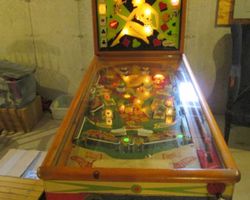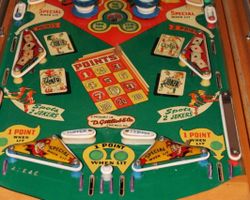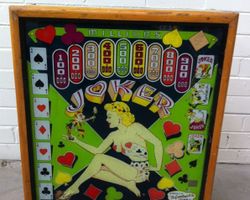Joker

Average Prices: USD $200 to $1,100
Produced: November, 1950
Production Run: 850 units
Machine Type: Electro-mechanical
Players: 1
Design by: Wayne Neyens
Art by: Roy Parker
The "Joker" pinball machine, released by D. Gottlieb & Co. in November 1950, emerged during a dynamic period for electro-mechanical (EM) games. With a production run of 850 units, this Model 44 machine embraced a familiar and broadly appealing theme: the world of cards, casinos, and poker. The game’s conceptualization, mechanical design, and animation were primarily handled by Wayne Neyens, a figure whose contributions would shape numerous Gottlieb titles. Complementing Neyens' mechanical ingenuity was the distinctive artwork of Roy Parker, who rendered the game's vibrant backglass and playfield. This collaboration aimed to create a visually striking and mechanically engaging experience for players. "Joker" entered a market eager for new gameplay innovations, even subtle ones within the EM framework, setting itself apart with specific design choices and a focus on card-based scoring objectives.
Signature Features and Design
"Joker" features several distinct elements that define its character and gameplay. Most prominent is its striking backglass, a testament to Roy Parker’s artistic vision. The backglass prominently displays a spread of seven aces and four jokers, which illuminate as players achieve specific objectives throughout the game. This visual feedback on the backglass serves as a clear, immediate indicator of progress towards scoring goals, enhancing player engagement beyond merely accumulating points.
Mechanically, "Joker" boasts a notable configuration of seven bumpers—three pop bumpers and four passive bumpers—a generous number for its era. These bumpers contribute significantly to the ball's movement and provide numerous opportunities for incidental scoring. A single kick-out hole adds another interactive element, often returning the ball to play in a predictable manner or triggering a specific reward.
The most discussed and unique mechanical alteration lies in its flipper configuration. While the game features two flippers, their physical orientation or placement on the playfield is described as "reversed" or unusual. Despite this physical characteristic, the control scheme remains standard: the left flipper button activates the flipper positioned on the left side of the playfield, and the right flipper button operates the flipper on the right. This unusual physical setup, even with standard controls, fundamentally alters the expected angles and rebounds of the ball, demanding a different approach to aiming and ball control compared to other machines of the period. The absence of slingshots and spinning discs further emphasizes the role of the flippers, bumpers, and kick-out hole in managing ball flow and scoring.
Playfield and Mechanics
The "Joker" playfield is a carefully arranged canvas designed around its card-themed objectives and numerous bumper elements. The prominent central area is dominated by the cluster of seven bumpers, strategically placed to create lively ball action. Three pop bumpers deliver forceful kicks, propelling the ball unpredictably, while four passive bumpers offer deflections and caroms. These bumpers, along with other targets, serve as the primary means of lighting the "aces" and "jokers" displayed on the backglass.
The two flippers are positioned at the bottom of the playfield, albeit with their distinctive "reversed" physical layout. This physical arrangement dictates unique shot angles, requiring players to adapt their aim to compensate for the altered geometry, even with standard left-to-left, right-to-right button mapping. A kick-out hole is integrated into the playfield, likely positioned to reward specific shots or to return the ball to a central area, setting up further scoring opportunities. The playfield artwork, consistent with Roy Parker’s backglass design, is rich with card suits, playing card imagery, and casino motifs, immersing players in the game’s theme. The lighting on the playfield works in conjunction with the backglass objectives, illuminating targets that contribute to lighting the aces and jokers, guiding the player's focus and indicating progress. The overall aesthetic is characteristic of early 1950s EM machines, combining painted wooden rails, a vibrant playfield, and mechanical score reels.
Gameplay Dynamics
"Joker" offers a focused and engaging gameplay experience centered on its card-themed objectives. The primary goal is to light up the seven aces and four jokers on the backglass, which are illuminated by hitting specific targets and activating switches on the playfield. Each successful activation progresses the player towards completing these sets, which in turn leads to higher scores and replay opportunities.
The scoring system encourages both precision and consistent ball action. Points are awarded for hitting various targets and bumpers, but the true progression comes from the strategic lighting of the card objectives. This dual scoring mechanism—direct points from playfield elements and objective-based scoring on the backglass—provides multiple avenues for players to pursue high scores. The game offers two distinct methods for earning extra replays, a feature appreciated by players seeking extended playtime: one tied to achieving specific point totals on the playfield, and another contingent upon fulfilling the card lighting objectives on the backglass. This layered approach to replays adds significant depth and replayability.
The unique physical flipper setup presents a substantial challenge, distinguishing "Joker" from other machines. Players must adapt to the unconventional angles and trajectories the ball takes when launched from these flippers, which often necessitates different aiming strategies and a re-evaluation of shot execution. Successfully navigating the dense field of seven bumpers requires a blend of luck and skillful nudging, as the ball caroms off surfaces, ideally towards the targets needed to light the next ace or joker. Strategic gameplay involves identifying which targets contribute to the desired card objectives and attempting to guide the ball into those areas, while simultaneously managing the ball to prevent drains.
Reception and Legacy
"Joker" by Gottlieb garners a mixed yet generally positive reception within the pinball community. Its primary strength, frequently highlighted, is its capacity to be a "player's game." This refers to its depth and the engaging experience it offers to those willing to master its intricacies. The backglass art, a signature of Roy Parker, is consistently praised as one of the most visually appealing of its era, drawing players in with its vibrant card theme. The availability of multiple replay opportunities, both through playfield points and backglass objectives, is also seen as a significant positive, extending gameplay and rewarding skilled play. The abundant seven bumpers contribute to a lively and often unpredictable playfield, adding to the entertainment.
However, the machine’s most significant and frequently cited drawback is its unusual flipper configuration. While the controls themselves operate in a standard left-to-left, right-to-right fashion, the physical layout or orientation of the flippers is described as "reversed" or atypical. This unique physical setup demands a period of adjustment, requiring players to adapt their aiming and ball control techniques, which some find counter-intuitive. This characteristic often leads to the game being overlooked or misunderstood by those accustomed to more conventional flipper layouts.
Despite its unique flipper challenge, "Joker" holds a place as an intriguing example of early 1950s electro-mechanical design. Its card-themed backglass objectives and layered scoring system represent an early exploration into more structured gameplay goals beyond simple point accumulation. While it may not have achieved widespread recognition compared to some of Gottlieb's later, higher-production titles, its distinct features and the challenge presented by its playfield layout make it a memorable experience for those who encounter it. "Joker" stands as a testament to Gottlieb's willingness to experiment with fundamental mechanical designs during a formative period in pinball history.
Sponsored Links
 Ebay Listings
Ebay Listings
 Auction Results
Auction Results
| Cost | Location | Date |
|---|---|---|
| USD $1,550 |  Ohio, United States Ohio, United States |
12 September, 2024 |
| USD $612 |  Connecticut, United States Connecticut, United States |
30 November, 2018 |
| USD $450 |  Massachusetts, United States Massachusetts, United States |
27 September, 2014 |
| USD $379 |  Maine, United States Maine, United States |
27 April, 2014 |
| AUD $300 |  Victoria, Australia Victoria, Australia |
26 September, 2013 |


Private Policy · Search Website · Contact Us
As an eBay Partner, we may earn a commission from qualifying purchases made through links on this site, at no additional cost to you.
All trademarks and copyrighted materials remain property of their respective owners. All other content copyright 2007 - 2025 Pinpedia.




